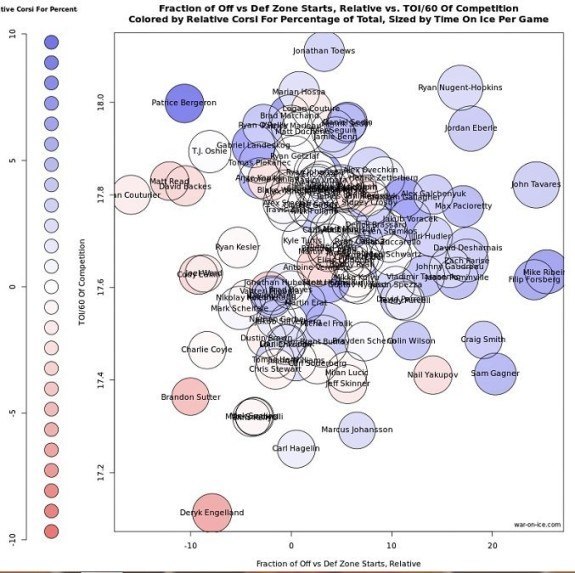Matt Read is a prototypical late-bloomer. He was 24 years old when he signed his entry-level contract with the Philadelphia Flyers and he was 25 before he even tasted the NHL. However, he immediately became an impact player.
In each of his two full NHL seasons prior to 2014-2015 Read scored more than 20 goals, and he was at about a 20 goal pace during the lockout shortened 2013 season.
The 2014-2015 season, Read’s fourth in the NHL, was a season to forget. He scored just eight goals, added 22 assists, setting a career low in both goals and points per game.

Not only were Read’s stats below his career norms, but he looked out of place for much of the season. His quick bursts of speed that fans have become accustomed to were non-existent, his pin-point shot seemed to constantly miss the mark, and his usually sound defensive play was sloppy.
This look at Read’s season will focus on three important issues. First, the ankle injury that plagued him throughout the season. Second, his usage, which will hopefully put his season into context. Third, how Read will rebound from the 2014-2015 disaster.
Playing On One Leg
In mid-January Matt Read revealed to the media that he had played much of the season with an ankle sprain. By that point in the season, fans were wondering why Read had looked so much worse than expected. It was almost a relief to know that he was playing injured, because otherwise there would have been serious questions about his play.
Read’s most frequent linemate (both at 5v5 and on the penalty kill), Sean Couturier, knew that this injury was affecting Read’s game. Couturier went so far as to say, “there was a stretch there where he was playing on one leg.”
Read stated that the ankle injury was suffered on November 1st, during the teams 11th game of the season. In mid-January, about 35 games later, Read told the media that he was feeling better. However, he did not seem to be back to 100% until the final weeks of the season.
Knowing the dates of the injury can help to quantify the effect that this injury had on his game. In the first 10 games of the season, Read had one even strength goal. After suffering the ankle injury, he scored just one even strength goal over his next 35 games! Over the course of those 35 games Read’s shooting percentage dropped below two percent.
There is little doubt that Read’s injury had an effect on his scoring touch. Read was laboring on the ice and unable to make plays in front of the net. As the season progressed, Read finally began to come back to form, but it happened too late to salvage the season.
Set Up To Fail
Because he is a frequent linemate of Sean Couturier, Matt Read was set up to fail from the beginning of the season. At even strength he played some of the hardest minutes of any forward in the NHL.
Take a look at this chart from war-on-ice.com. The chart measures the zone starts and Corsi % of every NHL forward who played at least 1000 even strength minutes last season.
As you can see, Couturier had the worst zone starts relative to his team in the NHL. What is also clear is that Matt Read was not far behind.
In 2014-2015, Read started 266 even strength shifts in the offensive zone and 365 even strength shifts in the defensive zone, giving him a 42.16 zone start percentage. Among NHL forwards who played at least 1000 even strength minutes, only Chris Stewart, Sean Couturier, and Derek Engelland had a worse percentage. Although Read has always played tough minutes, 42.16% is the worst zone start percentage of his career.
On top of his even strength time, Read averaged two minutes per game on the penalty kill, while only getting about a minute and a half per game on the power play. Most of that power play time was on the second unit which contained the likes of Vincent Lecavalier, R.J. Umberger, and Andrew MacDonald.
It is hard to nit pick Matt Read’s season. He took on tough minutes while battling through an injury. But there is hope for next season.
Regression To The Norm
When speaking of stats in sports, the word regression is usually seen in a negative light. It typically refers to a player or team overachieving and then regressing back to what their numbers indicate.

However, Matt Read is an example of positive regression. His career shooting percentage is 12.5% and he has been reliable for 20 goals in every NHL season prior to 2014-2015. In 2014-2015, Read’s shooting percentage was 5.6% and he scored just eight goals.
The bottom line is this. Although Matt Read may be approaching the end of his prime, there is no reason to believe that he will have a repeat season in 2015-2016. As long as he stays healthy and is given reasonable usage, it can be expected that Read’s numbers to regress back to his career norms.
By my estimation, Matt Read was the Flyers’ most disappointing player of the 2014-2015 season. I did not expect Vincent Lecavalier, R.J. Umberger or Ray Emery, all of whom did not perform well this season, to be key contributors. Read, however, has been very reliable.
But once the season is taken into context, it is clear why Matt Read had a forgettable season. He one Flyer who is poised to bounce back in 2015-2016.
